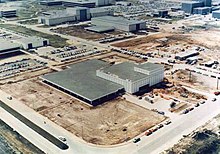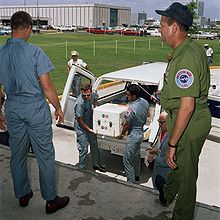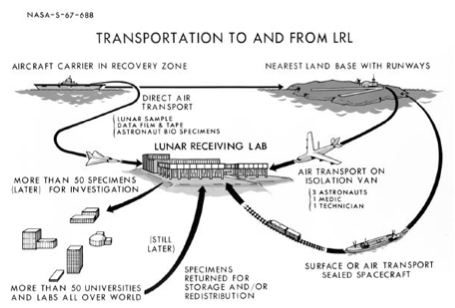Lunar Receiving Laboratory
This article includes a improve this article by introducing more precise citations. (April 2011) ) |


The Lunar Receiving Laboratory (LRL) was a facility at
The quarantine requirement was dropped for Apollo 15 and later missions.[1] The LRL was used for study, distribution, and safe storage of the lunar samples. Between 1969 and 1972, six Apollo space flight missions brought back 382 kilograms (842 pounds) of lunar rocks, core samples, pebbles, sand, and dust from the lunar surface—in all, 2,200 samples from six exploration sites.[2] Other lunar samples were returned to Earth by three automated Soviet spacecraft, Luna 16 in 1970, Luna 20 in 1972, and Luna 24 in 1976, which returned samples totaling 300 grams (about 3/4 pound).
In 1976, some of the samples were moved to
In September 2019, NASA announced that the Lunar Receiving Laboratory had not been used for two years and would be demolished.[5][6]
See also
Notes
- ^ Kent Carter (2001). "Moon Rocks and Moon Germs. A History of NASA's Lunar Receiving Laboratory". National Archives. Retrieved March 26, 2023.
All crew quarantine requirements were waived after the flight of Apollo 14.
- ^ "Lunar Rocks and Soils from Apollo Missions". NASA. March 31, 2022. Retrieved March 26, 2023.
- ^ "Lunar Sample Laboratory Tour". NASA. May 31, 2022. Retrieved March 26, 2023.
- ^ "Building on a Mission: The Lunar Receiving Laboratory". NASA. October 13, 2021. Retrieved March 26, 2023.
- ^ Stuckey, Alex (2019-09-20). "NASA to tear down building where Neil Armstrong, colleagues were quarantined after moon mission". Houston Chronicle. Retrieved 2023-01-05.
- ^ "NASA says 1969 moon landing lab to be demolished next year - The Washington Post". The Washington Post. 2019-09-25. Archived from the original on 2019-09-25. Retrieved 2023-01-05.
External links
- Lunar Receiving Laboratory Project History NASA/CR–2004–208938, 2004
- 25 Years of Curating Moon Rocks, Judy Allton
- Apollo Lunar Quarantine

